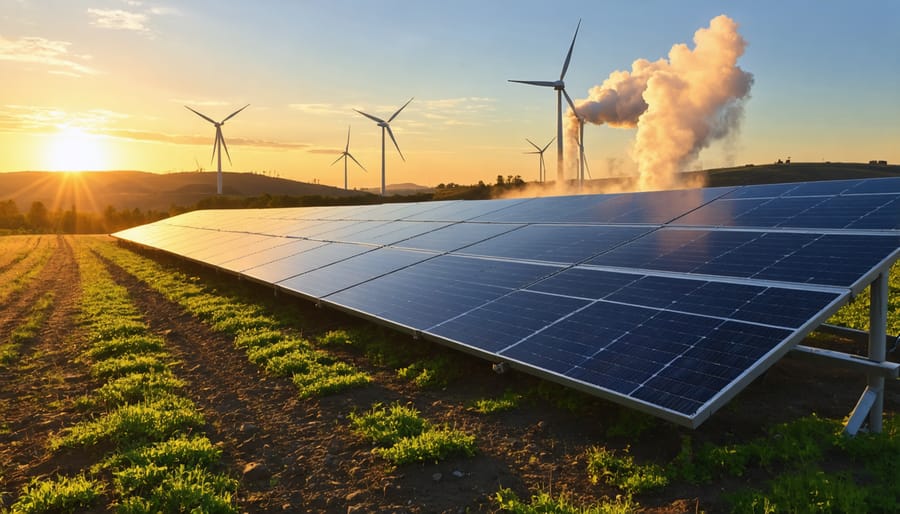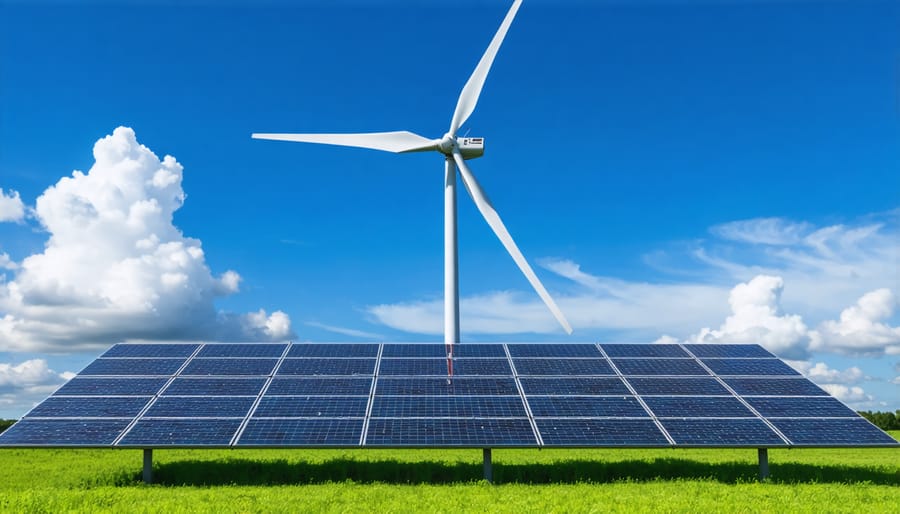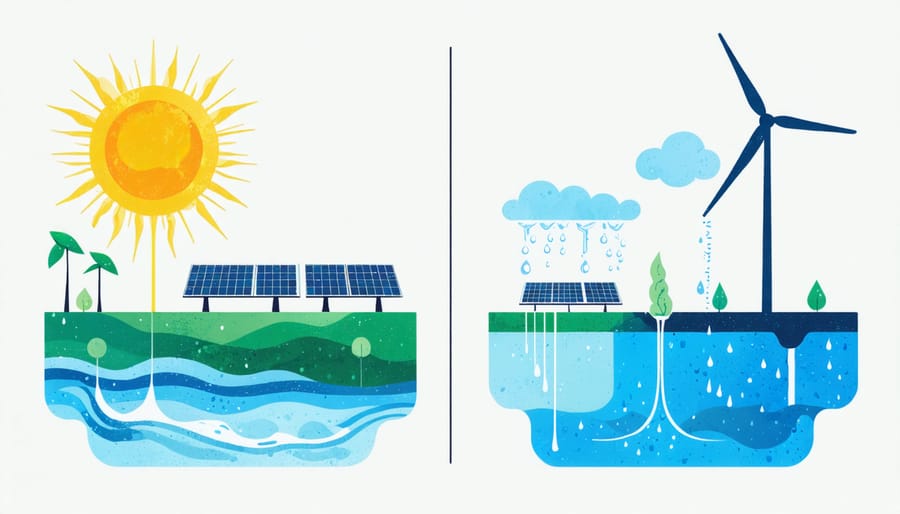
As the world faces a climate crisis, renewable energy has emerged as a beacon of hope for the environment. By harnessing the power of the sun, wind, water, and earth, clean energy sources like solar, wind, hydro, and geothermal are revolutionizing the way we power our planet. Renewable energy not only reduces greenhouse gas emissions and air pollution, but also protects biodiversity, preserves ecosystems, and conserves precious natural resources.
The shift to renewables is critical for safeguarding the delicate balance of life on Earth. Fossil fuels have long wreaked havoc on the environment, from oil spills devastating marine habitats to coal mining destroying forests. In contrast, renewable energy minimizes habitat destruction, allowing wildlife to thrive and ecosystems to flourish.
However, the transition is not without challenges. Careful planning is essential to mitigate potential impacts like habitat fragmentation from large-scale solar and wind farms. By prioritizing brownfield development, conducting thorough environmental assessments, and implementing sustainable land management practices, we can optimize renewable energy’s environmental benefits.
The power to heal our planet is within our grasp. By embracing renewable energy, we can create a cleaner, greener future for all living beings, from the tiniest microorganisms to the largest mammals. The time to act is now – for the sake of our environment and the countless species that call Earth home.

Reducing Greenhouse Gas Emissions
Impact on Global Warming
Renewable energy plays a crucial role in mitigating global warming by reducing greenhouse gas emissions. According to the IPCC, switching to renewable energy could limit global temperature rise to 1.5°C above pre-industrial levels by 2100, compared to a projected 3-4°C rise under current emissions scenarios. This reduction could prevent the most severe consequences of climate change, such as sea level rise, extreme weather events, and ecosystem collapse. By replacing fossil fuels with clean energy sources like solar, wind, and hydropower, we can significantly decrease CO2 emissions and slow the rate of global warming. Studies show that a rapid transition to 100% renewable energy by 2050 could reduce CO2 emissions by 80% compared to current levels. While challenges remain, the potential of renewable energy to combat climate change is immense, offering hope for a more sustainable future.
Protecting Marine Ecosystems
The shift towards renewable energy not only reduces greenhouse gas emissions but also plays a vital role in safeguarding marine ecosystems. As atmospheric CO2 levels rise, the oceans absorb more carbon dioxide, leading to ocean acidification. This process alters the chemical balance of seawater, making it more acidic and threatening the survival of calcifying organisms like corals, mollusks, and some plankton species. By curbing emissions, renewable energy helps mitigate the devastating effects of ocean acidification on these vulnerable marine life forms.
Moreover, the transition to clean energy sources reduces the risk of oil spills and other fossil fuel-related accidents that can severely damage marine habitats. Coral reefs, seagrass beds, and mangrove forests serve as nurseries for countless species and protect coastlines from erosion. Preserving these fragile ecosystems is crucial for maintaining biodiversity and the overall health of our oceans.
Preserving Biodiversity
Safeguarding Marine Life
The transition to renewable energy sources not only reduces greenhouse gas emissions but also helps safeguard diverse marine ecosystems. Coral reefs, for example, are particularly vulnerable to the impacts of climate change, such as ocean acidification and rising water temperatures. By minimizing the burning of fossil fuels, renewable energy helps mitigate these threats, giving coral reefs a better chance of survival. Additionally, offshore wind farms can serve as artificial reefs, providing new habitats for various marine species. Studies have shown that the foundations of wind turbines attract a wide range of fish and invertebrates, leading to increased biodiversity in the surrounding areas. Furthermore, the reduced reliance on oil and gas extraction decreases the risk of devastating oil spills, which can have long-lasting effects on marine life. By embracing renewable energy, we can create a cleaner, healthier environment for countless sea creatures, from the tiniest plankton to the largest whales.

Protecting Migratory Birds
Renewable energy sources, such as wind and solar power, significantly reduce risks to migratory birds compared to traditional oil and gas extraction. Oil spills can be devastating to bird populations, contaminating their food sources, nesting sites, and causing direct harm through exposure to toxic substances. In contrast, properly sited and managed renewable energy infrastructure poses minimal threats to birds. While wind turbines can cause collisions, these impacts are much lower and can be mitigated through careful planning and monitoring. By transitioning to clean energy, we can protect the critical habitats and migration routes that birds rely on for survival.

Conserving Water Resources
Water is a precious and often scarce resource, but renewable energy sources like solar and wind power are helping to alleviate this issue. Unlike traditional power sources such as coal, natural gas, and nuclear energy, which require vast amounts of water for cooling and other processes, solar and wind energy have minimal water requirements. In fact, a study by the National Renewable Energy Laboratory found that solar photovoltaic systems use up to 200 times less water per unit of electricity compared to a coal-fired power plant. Wind turbines also require very little water, primarily for occasional blade cleaning and equipment maintenance.
By reducing the demand for water-intensive energy sources, the adoption of solar and wind power can help to conserve our limited freshwater resources. This is particularly important in regions facing water scarcity, where the competition between energy production and other water needs, such as agriculture and human consumption, is most acute. As we continue to shift towards renewable energy, we can not only reduce greenhouse gas emissions but also protect our vital water resources for future generations. The water-saving benefits of solar and wind power demonstrate how renewable energy can have far-reaching positive impacts on the environment.
Challenges and Solutions
While renewable energy sources offer significant environmental benefits, they can also present challenges that require careful management and mitigation strategies. One potential issue is land use, as large-scale renewable energy projects like solar farms and wind turbines require substantial areas for installation. This can lead to habitat loss and fragmentation, impacting wildlife populations and biodiversity. To address this, project developers can prioritize using already disturbed lands, such as former agricultural fields or industrial sites, and implement wildlife-friendly design features like bird-safe wind turbines and wildlife corridors.
Another concern is the impact of renewable energy infrastructure on wildlife, particularly birds and bats. Wind turbines can cause collisions and fatalities, while solar farms may disrupt migration patterns and foraging behaviors. Rigorous environmental impact assessments and ongoing monitoring are crucial for identifying and minimizing these risks. Strategies like careful site selection, operational adjustments during peak migration periods, and the use of advanced radar and GPS tracking technologies can help reduce wildlife impacts.
The manufacturing and disposal of renewable energy components, such as solar panels and batteries, can also have environmental consequences. The production of these technologies often involves mining and processing of raw materials, which can contribute to pollution and habitat disturbance. Responsible sourcing practices, as well as robust recycling and disposal programs for end-of-life components, are essential for minimizing these impacts and promoting a circular economy.
By proactively addressing these challenges through research, innovation, and collaborative partnerships, the renewable energy sector can continue to drive the transition to a low-carbon future while safeguarding the health and resilience of our planet’s ecosystems. As we work to scale up renewable energy deployment, it is crucial that we do so in a manner that prioritizes environmental stewardship and the protection of biodiversity.
The Big Picture
When implemented responsibly, renewable energy has an overwhelmingly positive impact on the environment. By harnessing the power of the sun, wind, and water, we can significantly reduce greenhouse gas emissions and slow the pace of climate change. This, in turn, helps protect biodiversity and the delicate balance of ecosystems worldwide. Renewable energy sources also have a much smaller land and water footprint compared to fossil fuels, meaning less habitat destruction and pollution.
Furthermore, renewable energy’s role in mitigating ocean acidification and sea level rise is crucial for the survival of marine life. By investing in renewable energy infrastructure and policies, we can create a more sustainable future for both humans and the countless species we share this planet with. While challenges remain, the overall impact of renewable energy on the environment is undeniably positive and offers hope for a brighter, cleaner future.
In conclusion, renewable energy is a powerful tool in the fight against climate change and environmental degradation. By harnessing the infinite power of the sun, wind, and water, we can reduce our reliance on fossil fuels and minimize the harmful emissions that threaten our planet’s delicate ecosystems. The benefits of renewable energy extend far beyond the reduction of greenhouse gases – it also helps to conserve precious water resources, protect biodiversity, and create a more sustainable future for generations to come.
However, the transition to renewable energy is not without its challenges. It will require significant investment, infrastructure changes, and a collective effort from individuals, businesses, and governments alike. But the cost of inaction is far greater – we cannot afford to continue down the path of fossil fuel dependence and environmental destruction.
As individuals, we all have a role to play in supporting the shift to renewable energy. Whether it’s advocating for policies that promote clean energy, investing in renewable technologies, or simply making eco-friendly choices in our daily lives, every action counts. By working together and embracing the power of renewable energy, we can create a brighter, cleaner future for our planet and all its inhabitants. The time to act is now – let’s join forces and make renewable energy the norm, for the sake of our environment and all the precious life it sustains.
Weston Goyette
Weston Goyette is a passionate advocate for marine conservation and sustainability. With a background in marine biology and environmental science, Weston has dedicated his career to exploring the intricate relationships within ocean ecosystems and promoting strategies to protect them. At the Marine Biodiversity & Sustainability Learning Center, Weston contributes insightful articles that delve into topics such as endangered species protection, climate change impacts on marine life, and sustainable practices for preserving our oceans. His writings aim to educate and inspire readers to take actionable steps toward environmental stewardship. Beyond his written work, Weston actively participates in community outreach programs, engaging with local schools and organizations to raise awareness about marine conservation. His commitment to both scientific research and public education makes him a valuable asset to the Center's mission.
